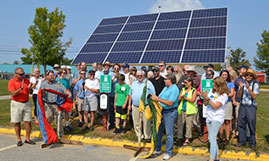2024 Measures of Growth Report Highlights 30 Years of Economic Change in Maine
Bath, Maine – November 20, 2024 The nonpartisan Maine Economic Growth Council today released its 30th annual Measures of Growth report – a comprehensive snapshot of how the state’s economy is performing relative to our long-term goals, other states, and the nation.
The report finds that overall, Maine continues to perform exceptionally well in terms of environmental stewardship, and it has made significant gains in internet connectivity and transportation infrastructure. These areas were recognized with Gold Stars. The economy is diversifying and growing, broadband internet connectivity continues to expand apace, and postsecondary training and education remains at all-time highs. However, children’s mental health and learning, labor force challenges, and the high costs of housing and energy pose systemic challenges that continue to burden communities, businesses, and households. These areas were assigned Red Flags for “needs attention”.
“The three decades since Measures of Growth debuted have been ones of remarkable change,” says Steve Von Vogt, CEO, Maine Marine Composites and Co-Chair of the Maine Economic Growth Council. “The population is older, with unfilled jobs chasing too few workers, and economic activity has shifted from manufacturing to services and from rural to urban areas. While this has sharply challenged some rural communities, it has energized many to reimagine themselves and their economies to meet present and future needs. This report highlights ways in which Maine is building on its unique strengths in every region through ingenuity, innovation, and public-private partnerships to create new opportunities – including next-generation manufacturing.”
In this 30th-anniversary edition, the report also highlights four examples of creative initiatives that are helping address some of Maine’s longstanding challenges. Bucksport is diversifying its economic base, Dover-Foxcroft is investing in climate resilience, MEMIC is embracing the talents of an older workforce, and Bath is expanding affordable housing opportunities.
“When it comes to building affordable housing in Maine, you need a community-minded developer willing to take it on, municipal and community collaborators, and multi-tiered public-private funding partners to not only break even but to keep the housing affordable long term,” says Amy Cullen, Vice President & Project Partner, The Szanton Company, and former Chair of the Maine Affordable Housing Coalition. “The Uptown complex featured in this year’s report is an example of the kind of new housing models every community in Maine needs to embrace so residents and workers have homes.”
The report also notes developments outside the scope of its metrics that will have serious implications for Maine communities and businesses in the coming years. Two significant challenges that were little known 30 years ago and have roots in actions taken (or not taken) at that time are climate change and PFAS (per- and polyfluoroalkyl substances or ‘forever chemicals’). Overcoming these challenges will require unprecedented levels of coordination and public investment.
In total, the 2024 Measures of Growth Report tracks 31 indicators that represent Maine’s assets and areas of challenge. Overall, the state made measurable progress on 6 indicators, lost ground versus the benchmark on 9, and held its ground on 16.As always, the Council assigned Gold Stars for high standing or good progress and Red Flags for notable gaps or adverse trending.
The Council assigns Gold Stars for significant progress in:
- Internet Connectivity: In 2024, 89% of Maine locations have either average or broadband internet, up 3%.
- Transportation: In 2023, 72% of Maine roadways were rated good or fair, up 5%.
- Sustainable Forestlands: In 2022, the 10-year growth-to-removal ratio fell 4% to 1.51 but it remains well above the sustainability goal.
- Greenhouse Gas Emissions: From 2020 to 2021, GHG emissions rose 1.4% but still show major progress toward the long-term goal.
The Council assigns Red Flags for needed attention to:
- Labor Force: Maine’s labor force grew 1% to 687,000 in 2023 but remains a serious challenge.
- 4th and 8th Grade Test Scores: In 2022, just 29% of Maine 4th graders were proficient in reading and 24% of Maine 8th graders were proficient in mathematics. These are sharp drops from pre-COVID levels.
- Cost of Energy: The price of industrial electricity rose 13% in 2023, in contrast to a decline nationwide.
- Housing Affordability: In 2023, the share of households unable to afford the median-priced home rose to 79%.
- Mental and Behavioral Health: In 2021-2022, the percentage of children with a mental and/or behavioral condition rose 4%.
“Ultimately, the report makes crystal clear that our economic success depends on our people: attracting and retaining the talent pool that drives our economy; equipping kids and our current workers with the knowledge and skills to succeed; and tackling the physical, mental, and access barriers to enable all Mainers in all corners of the state to realistically achieve prosperity and self-worth,” says Yellow Light Breen, President & CEO of MDF (Maine Development Foundation). “The data presented in this report illustrates how Maine’s economy has expanded and is more innovative than ever – and that will take an expanding and innovative workforce.”
The Maine Economic Growth Council takes a nonpartisan, data-driven approach to presenting an
unbiased picture of Maine’s economy and well-being. Measures of Growth is designed to be a resource for policy and decision makers at all levels, helping them to focus their efforts and understand the connections between the key issues affecting the state. The report works in tandem with the
Maine 2020-2029 Economic Development Strategy: 2024 Reset to inform policy and decisions in order to achieve overarching goals of growing Maine’s talent pool and workforce, increasing wages, and increasing the value of what we sell per worker. The Council is administered by the Maine Development Foundation (MDF). You can find a digital, interactive version of the report here. To print a PDF version, click here.







